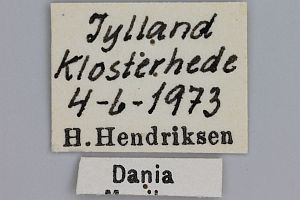2. Diagnose
2.1. Geschlecht nicht bestimmt
2.2. Erstbeschreibung
3. Biologie
3.1. Nahrung der Raupe
- [Orobanchaceae:] Pedicularis palustris (Sumpf-Läusekraut)
- [Menyanthaceae:] Menyanthes trifoliata (Fieberklee)
- [Juncaginaceae:] Triglochin ??? (Dreizack ???)
Beavan & Heckford (2012: 71) erläutern in ihrer Arbeit zu Gynnidomorpha permixtana: "Barrett (1881: 70) observed the species at the beginning of June 1881, again ‘near Pembroke’, exact locality and habitat not given. He states that the foodplant was still unknown and that a rumour that it had been bred from Pedicularis palustris L. did not seem to be confirmed. Pedicularis palustris was subsequently shown by Richardson (1891: 239–240; 1892: 173–176) to be the larval foodplant of the very similar Gynnidomorpha minimana (Caradja, 1916)."
Kennel (1913: 276) hatte zu "Phalonia geyeriana HS." noch einmal Richtiges und Falsches miteinander vermengt: "Die Raupe ist blaß bräunlich, Kopf und Nackenschild sind schwarzbraun ; sie lebt vom Herbst bis Frühling in Samenkapseln von Pedicularis palustris; nach Sorhagen auch in Blütenstielen von Alisma plantago".
Angaben zu Menyanthes oder Triglochin bei Razowski (2001: 38) sind mit Unsicherheit behaftet bzw. mit hoher Wahrscheinlichkeit falsch. Die Angabe zu Triglochin dürfte auf einer Verwechslung mit Gynnidomorpha vectisana beruhen.
Hancock et al. (2015: 48) wiederholen allerdings den Fieberklee, leider ohne Primärangabe: "Feeds in seed capsules of marsh lousewort (Pedicularis palustris) in July and again in September. Larvae also reared from seedpods of bog-bean (Menyanthes trifoliata) (Bradley, Tremewan and Smith, 1973)."
Itämies (2011: 59) bestätigte Menianthes trifoliata und bemerkte dabei, dass es auch ohne heranreifende Früchte geht: "G. minimana is known to feed on seeds of Pedicularis palustris, Triglochin and Menyanthes. I did rear the species from seedless stems of Menyanthes trifoliata, which indicates that the larvae do not necessarily need seeds to complete their development. Shoots infested by G. minimana were distinguishable from uninfested ones by leaves that were wilted but still green."
(Autor: Erwin Rennwald)
4. Weitere Informationen
4.1. Andere Kombinationen
- Conchylis minimana Caradja, 1916 [Originalkombination]
4.2. Synonyme
- Phalonia walsinghamana Meyrick, 1928
4.3. Faunistik
Zum Vorkommen in Deutschland siehe Segerer et al. (2013).
4.4. Literatur
- Beavan, S. D. & R. J. Heckford (2012): Discovery of the larva of Gynnidomorpha permixtana ([Denis & Schiffermüller], 1775) (Lepidoptera: Tortricidae) in the British Isles and a consideration of the species' distribution there. — Entomologist's Gazette 63: 69-83 [PDF auf devonmoths.org.uk].
- Erstbeschreibung: Caradja, A. (1916): Beitrag zur Kenntnis der geographischen Verbreitung der Pyraliden und Tortriciden des europäischen Faunengebietes, nebst Beschreibung neuer Formen. — Deutsche Entomologische Zeitschrift „Iris“ 30: 1-88, 151-152. Dresden.
- Hancock, E.F., Bland, K.P. & J. Razowski (2015): The moths and butterflies of Great Britain and Ireland. Volume 5 (Part 1). Tortricidae, Tortricinae & Chlidanotinae. - 245 S.; Leiden & Boston (Brill).
- Itämies, J. (2011): Piirteitä kuusiokätkökääriäisen [Gynnidomorpha minimana (Caradja, 1916)] toukkabiologiasta. Gynnidomorpha minimana (Caradja, 1916) larvae do not feed obligatorily. — Baptria, 36 (2): 59. [PDF (ganzes Heft) auf perhostutkijainseura]
- Kennel, J. (1913): Die Palaearktischen Tortriciden. Eine monographische Darstellung. — Zoologica, 21 (54): 1-546. [PDF auf zobodat.at]
- Razowski, J. (2001): Die Tortriciden (Lepidoptera, Tortricidae) Mitteleuropas. Bestimmung - Verbreitung - Flugstandort - Lebensweise der Raupen. — 319 S.; Bratislava.
- Richardson, N.M. (1891): The larva of Eupoecilia geyeriana. — The Entomologist’s Monthly Magazine, 27: 239–240. [Digitalisat auf biodiversitylibrary.org]
- Segerer, A. H., Lichtmannecker, P., Grünewald, T. & E. Lohberger (2013): Aktuelle Vorkommen einiger wenig bekannter Schmetterlingsarten in Deutschland (Lepidoptera, Nepticulidae, Gracillariidae, Gelechiidae, Tortricidae, Crambidae). — Entomologische Nachrichten und Berichte 57 (3): 121-126.




![Vorkommen in Norwegen (außer Spitzbergen und Jan Mayen) [Aarvik & al. (2017): Nordic-Baltic Checklist]](/res/img/flag/no.gif)
![Vorkommen in Dänemark (außer Färöer-Inseln und Grönland) [Aarvik & al. (2017): Nordic-Baltic Checklist]](/res/img/flag/dk.gif)
![Vorkommen in Schweden [Aarvik & al. (2017): Nordic-Baltic Checklist]](/res/img/flag/se.gif)
![Vorkommen in Finnland (außer Åland-Inseln) [Aarvik & al. (2017): Nordic-Baltic Checklist]](/res/img/flag/fi.gif)
![Vorkommen in Russland (europäischer Teil bis Manytsch-Niederung) [Sinev (2021)]](/res/img/flag/ru.gif)
![Vorkommen in Estland [Aarvik & al. (2017): Nordic-Baltic Checklist]](/res/img/flag/ee.gif)
![Vorkommen in Lettland [Aarvik & al. (2017): Nordic-Baltic Checklist]](/res/img/flag/lv.gif)
![Vorkommen in Litauen [Aarvik & al. (2017): Nordic-Baltic Checklist]](/res/img/flag/lt.gif)
![Vorkommen in Polen [Buszko J. & J. Nowacki [eds] (2017): A Distributional Checklist of the Lepidoptera of Poland]](/res/img/flag/pl.gif)
![Vorkommen in Tschechien [nach Liška J. et al.(2014) Faunistic Records from the Czech Republic - 361]](/res/img/flag/cz.gif)

![Vorkommen in Ungarn [Pastorális et. al. (2018): A Magyarországon előforduló molylepke-fajok névjegyzéke]](/res/img/flag/hu.gif)
![Vorkommen in Großbritannien [Agassiz, Beavan & Heckford (2013): Checklist of the Lepidoptera of the British Isles]](/res/img/flag/gb.gif)
![Vorkommen in Irland einschließlich Nordirland [Bond & O'Connor (2012): Checklist of Irish Species]](/res/img/flag/ie.gif)
![Vorkommen in den Niederlanden [Kuchlein & de Vos (1999): Annotated Checklist of the Dutch Lepidoptera]](/res/img/flag/nl.gif)
![Vorkommen in Frankreich (europäisches Territorium ohne Korsika) [Vandromme et al. (2020): Liste systématique et taxinomique des Lépidoptères de France]](/res/img/flag/fr.gif)
![Vorkommen auf Korsika [Brusseaux, G. & J. Nel (2004)]](/res/img/flag/fr-cor.png)
![Vorkommen in Italien (Festland und kleine festlandsnahe Inseln) [Trematerra (1995): Checklist delle Specie della Fauna Italiana 85]](/res/img/flag/it.gif)
![Vorkommen in Rumänien [Rákosy L. & M. Goia (2021): Lepidopterle din România: lista sistematică şi distribuţie]](/res/img/flag/ro.gif)
![Vorkommen in Georgien [Nedoshivina, Ustjuzhanin, Kovtunovich, Streltzov & Yakovlev (2023)]](/res/img/flag/ge.gif)






